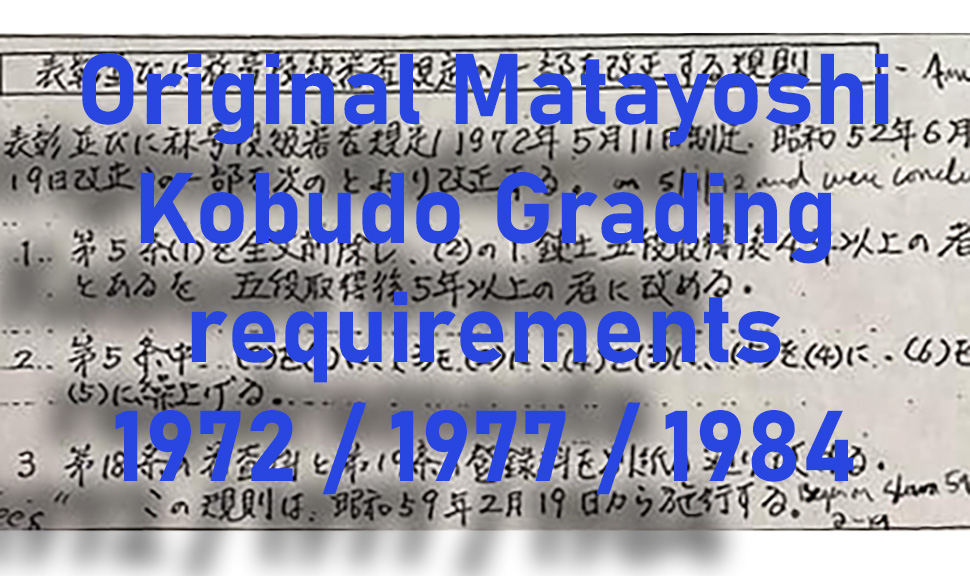All-Okinawa Kobudō Federation (Incorporated Body) – Teaching and Examination Subjects
Revised on February 19, 1984
3rd Kyū Examination Subjects (teaching subjects for those without kyū grade)
Qualification of candidacy for examination: Those who have been training for not less than 6 months after entering the school.
- 1. Bō techniques: supplementary exercises (hojo undō) No. 1
- 2. Sai technique: supplementary exercises
2nd Kyū Examination Subjects (teaching subjects for those with 3rd kyū grade)
Qualification of candidacy for examination: Those who have been training for not less than 6 months after acquiring the 3rd kyū.
- 1. Bō techniques: supplementary exercises No. 2
- 2. Tunkuwa techniques: supplementary exercises
1st Kyū Examination Subjects (teaching subjects for those with 2nd kyū grade)
Qualification of candidacy for examination: Those who have been training for not less than 6 months after acquiring the 2nd kyū.
- 1. Bō techniques: supplementary exercises No. 3
- 2. Sōsetsukon (nunchaku) techniques: supplementary exercises
1st Dan Examination Subjects (teaching subjects for those with 1st kyū grade)
Qualification of candidacy for examination: Those who have been training for not less than 6 months after acquiring the 1st kyū
- 1. Bō technique: Shūshi no Kon
- 2. Sai technique: Nichōsai (No. 1)
- 3. Partner techniques (kumi-waza): Individual creation or analysis (bunkai)
2nd Dan Examination Subjects (teaching subjects for those with 1st dan grade)
Qualification of candidacy for examination: Those who have been training for not less than 12 months after acquiring the 1st dan.
- 1. Bō technique: Chōun no Kon
- 2. Tunkuwa techniques: No. 1
- 3. Partner techniques: Individual creation or analysis (bunkai)
- 4. Assigned techniques: Specified by the examiners, chosen from the 1st dan techniques.
3rd Dan Examination Subjects (teaching subjects for those with 2nd dan grade)
Qualification of candidacy for examination: Those who have been training for not less than 12 months after acquiring the 2nd dan.
- 1. Bō technique: Sakugawa no Kon
- 2. Sōsetsukon (nunchaku) techniques: Sōsetsukon kata
- 3. Partner techniques: Individual creation or analysis (bunkai)
- 4. Assigned techniques: Specified by the examiners, chosen from the techniques up to the 2nd dan.
4th Dan Examination Subjects (teaching subjects for those with 3rd dan grade)
Qualification of candidacy for examination: Those who have been training for not less than 24 months after acquiring the 3rd dan.
- 1. Bō technique: Tsuken no Kon
- 2. Sai technique: Sanchōsai (No. 2)
- 3. Nunti technique: Nunti kata
- 4. Partner techniques: Individual creation or analysis (bunkai)
- 5. Assigned techniques: Specified by the examiners, chosen from the techniques up to the 3rd dan.
5th Dan Examination Subjects (teaching subjects for those with 4th dan grade)
Qualification of candidacy for examination: Those who have been training for not less than 36 months after acquiring the 4th dan.
- 1. Bō techniques: Soeishi no Kon
- 2. Tunkuwa techniques: No. 2
- 3. Kai (paddle) techniques: Tsuken Akanchū no Uēku-dī
- 4. Partner techniques: Individual creation or analysis (bunkai)
- 5. Assigned techniques: Specified by the examiners, chosen from the techniques up to the 4th dan.
Title Examination Subjects
- 1. Kata subjects: One type from among the subjects up to the 5th dan.
- 2. Elective subject: Special study subject from among cane (tsue / jō), three-section staff (sansetsukon), tekkō, techū, sickle (kama), weighted chain (suruchin), shield & machete (tinbē), hoe (kuwa), or others.
- 3. Partner techniques: Individual creation or analysis (bunkai)
- 4. Academic subject: Write thesis
Note: Qualification of candidacy for a title examination is a 5th Dan.
- Renshi 6th Dan – 5 years or more after obtaining 5th dan.
- Kyōshi 7th Dan – 5 years or more after obtaining Renshi 6th dan.
- Kyōshi 8th Dan – Those who have been Kyōshi 7th dan for 7 years or more.
- Hanshi 9th Dan – Those who have been Kyōshi 8th dan for 7 years or more.
- Hanshi 10th Dan –Those who have been Hanshi 9th dan for 10 years or more.
Partial Revision of the Regulation on Awards, Titles, Dan Ranks, and Kyū Grades
Parts of the Regulation on Awards, Titles, Dan Ranks, and Kyū Grades (enacted on May 11, 1972, revised on June 19, 1977) will be revised as per decision.
- 1. Article 5 (1) will be deleted in its entirety, and in (2) “no less than 4 years after obtaining Renshi 5th dan” will be changed to “no less than 5 years after obtaining the 5th dan.”
- 2. In Article 5, (2) is raised to (1), (3) to (2), (4) to (3), (5) to (4), and (6) to (5).
- 3. The examination items of Article 18 and the fees of Article 19 will be amended accordingly.
This regulation will be enforced from February 19, 1984.
(END)
Translator’s / editor’s note: The original was kindly provided by Ray Peet.
© 2022, Andreas Quast. All rights reserved.

